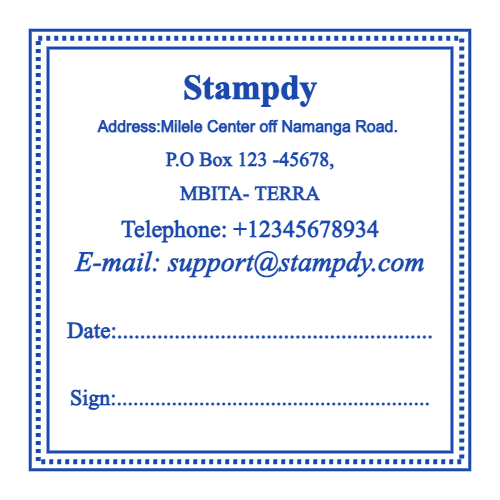Businness Stamps Templates
Free editable businness stamps templates for online editing
Found 5 businness stamps Templates





Business Stamps 101: What They Are, How to Use Them, and Which One You Need
If you run a small business, freelance, or manage an office, you know how much time goes into signing documents, marking invoices, or adding your business info to envelopes. That’s where a business stamp comes in—it turns repetitive tasks into a one-second job, keeps your paperwork consistent, and adds a professional touch that handwriting just can’t match. At Stampdy, our business stamp templates are made for all kinds of businesses, from tiny startups to local shops. This guide will walk you through everything you need to know about business stamps: what they do, the different types, and how to pick the right one for your workflow.
What Is a Business Stamp, and Why Do Businesses Need One?
A business stamp is a tool that imprints your business’s key info (like name, address, logo, or a specific message) onto documents, envelopes, or packages. Unlike generic stamps, business stamps are tailored to your brand—they’re not just for saving time, but for reinforcing who you are every time you send a letter or sign a form.
Let’s break down why they’re a must-have:
- Saves time: Instead of writing your business address on 50 invoices or signing 20 contracts by hand, a stamp does it in seconds. For busy business owners, that adds up to hours of saved time each month.
- Looks professional: A crisp, consistent stamp makes your business feel more trustworthy. Think about it—would you trust a quote from a company with messy handwritten info, or one with a clean, branded stamp?
- Reduces errors: Handwriting can lead to typos (like a wrong phone number) or smudges that make info unreadable. A stamp ensures every impression is perfect, so clients or partners never misread your details.
- Brands every touchpoint: Every envelope, invoice, or receipt with your stamp is a tiny reminder of your business. It’s a simple way to keep your brand top of mind without extra work.
The Most Useful Types of Business Stamps
Not all business stamps are the same—you’ll pick one based on what tasks you do most. Here are the four most common types, and who they’re best for:
1. Business Address Stamps
This is the foundational business stamp. It imprints your business’s name, full address, phone number, email, and sometimes website. It’s used for almost everything: envelopes, invoices, packing slips, or even notebooks for client meetings.
Who needs it:
- Any business that sends mail (retailers shipping orders, freelancers sending proposals, cafes mailing gift cards).
- Home-based businesses that want to keep their personal address private (use a PO box or business address on the stamp).
Example: A local bakery uses an address stamp on every order confirmation envelope—customers see the bakery’s name, address, and phone number, making it easy to reach them if there’s an issue.
2. Logo Stamps
A logo stamp adds your business’s logo (along with optional info like your name or tagline) to documents. It’s perfect for branding—turning plain paperwork into something that feels “on-brand.”
Who needs it:
- Businesses that want to reinforce their visual identity (graphic design firms, clothing brands, wellness studios).
- Anyone sending marketing materials (like flyers or brochures) or client gifts (like branded notebooks).
Pro tip: Make sure your logo file is high-resolution (300 DPI or more) when customizing—this ensures the stamp doesn’t look blurry. If you’re not sure how to prep your logo, our online stamp design maker can help you adjust it for a crisp impression.
3. “Paid” or “Received” Stamps
These stamps have a clear message: “Paid,” “Received,” “Approved,” or “Void.” They’re used to mark invoices, payments, or forms to track their status. No more scribbling “Paid” on a receipt—this stamp makes it obvious at a glance.
Who needs it:
- Accounting teams or business owners who process invoices (marks when a client has paid).
- Retailers who take cash or check payments (stamps receipts as “Received” to avoid disputes).
- Offices that approve forms (like expense reports or purchase orders).
4. Signature Stamps
If you sign a lot of documents (contracts, proposals, checks), a signature stamp is a game-changer. It imprints a copy of your handwritten signature, so you don’t have to sign each page individually. Most signature stamps also include your job title (like “Owner” or “Manager”) for extra clarity.
Who needs it:
- Business owners who travel often (sign documents remotely without printing and mailing).
- Managers who approve dozens of forms a day (saves time and reduces hand fatigue).
Important note: Signature stamps are legally binding, so keep yours in a secure place (like a locked drawer) to prevent misuse.
How to Choose the Right Business Stamp for Your Needs
Picking a business stamp is simple—just answer three questions about your business:
1. What Will You Use the Stamp For Most?
Start here—this will narrow down your options fast:
- If you send a lot of mail: Go with a business address stamp.
- If you want to boost branding: A logo stamp (or a combo of address + logo) is best.
- If you handle invoices or payments: A “Paid”/“Received” stamp is a must.
- If you sign lots of documents: A signature stamp will save you hours.
2. How Often Will You Use It?
Frequency matters for durability:
- Occasional use (10–20 times a week): A basic rubber stamp with a separate ink pad works fine. It’s affordable and easy to maintain.
- Frequent use (50+ times a week): A self-inking stamp is better. It has a built-in ink pad that recharges after each use, so you don’t have to stop and reink. Most self-inking stamps last for 5,000+ impressions before needing a refill.
If you’re not sure how to make a self-inking stamp work for your business, our stamp maker online guide walks you through the customization process step by step.
3. What Info Should You Include?
Don’t overcrowd your stamp—only add what’s essential. Here’s a quick guide:
- Address stamps: Name, address, phone number, email (skip website if it makes the text too small).
- Logo stamps: Logo + business name (keep it simple—too much text will blur).
- Message stamps: Clear message (“Paid”) + optional date (some have an adjustable date feature).
- Signature stamps: Signature + job title (avoid adding extra info—focus on making the signature look authentic).
Tips for Using Your Business Stamp Effectively
Once you have your stamp, these small tips will help you get the most out of it:
- Test it first: Before using it on important documents, stamp a piece of scrap paper to check if the ink is even and the text is readable. If it’s faint, add a little more ink (for rubber stamps) or press slightly harder (for self-inking ones).
- Stamp on flat surfaces: Use a desk or table—stamping on uneven surfaces (like a stack of papers) can cause smudges.
- Store it properly: Keep self-inking stamps in a cool, dry place (heat dries out the ink pad). Rubber stamps should be stored away from ink pads to avoid staining.
- Refill ink on time: If your self-inking stamp starts making faint impressions, refill it right away. Waiting too long can damage the ink pad.
Common Questions About Business Stamps
Q: Can I use a business stamp for legal documents?
A: Yes—signature stamps and “Approved” stamps are legally binding, as long as they’re used by the person authorized to sign (you or a designated employee). Just make sure to keep the stamp secure to prevent unauthorized use.
Q: Do I need a custom business stamp, or can I use a generic one?
A: Generic stamps (like a basic “Paid” stamp) work for simple tasks, but custom ones are better for branding. A custom stamp with your business name and logo turns every document into a branding opportunity—generic ones don’t do that.
Q: How long does a business stamp last?
A: It depends on use and material. A self-inking business stamp can last 2–3 years (with ink refills), while a rubber stamp can last even longer—since you just replace the ink pad when it runs out.
Q: Can I add my logo and address to the same stamp?
A: Absolutely! Combo stamps (logo + address) are popular for businesses that want to brand and share info at the same time. Just make sure the logo is small enough that it doesn’t crowd the address—our design tool lets you adjust sizes to get the balance right.
Why Choose Stampdy for Your Business Stamp?
When you’re picking a business stamp, you need something that’s durable, looks professional, and fits your brand. Here’s why Stampdy’s business stamp templates work for small businesses:
- Customizable to your brand: Add your logo, choose your font, and pick ink colors that match your brand (like navy for a law firm or bright green for a plant shop).
- Built to last: We use polymer (for sharp impressions) and high-quality ink pads (for fade-resistant text) so your stamp works for years.
- Easy to order: Our online tool lets you design your stamp in 5 minutes—no design skills needed. You’ll see a preview before you buy, so you know exactly what you’re getting.
- Fast shipping: Most custom business stamps ship in 1–2 business days, so you can start using it ASAP.
If you’re ready to save time and make your business look more professional, browse our business stamp templates today. Whether you need a simple address stamp or a branded logo stamp, we’ve got a design that fits your business.